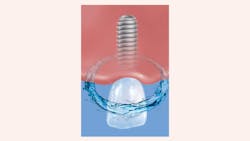Maintenance and disease treatment protocols for natural teeth, implants, and restorations
Restoration and natural teeth maintenance
Adult prophylaxis and periodontal disease maintenance
- Place OptraGate (Ivoclar Vivadent), a latex-free retraction device for visibility and protection of lips. Pull apart, place in corners of mouth, position in vestibular regions (figure 1).
- Use low-abrasion powder-streaming technology with erythritol or glycine powder to remove biofilm, or polish with silica paste containing xylitol (e.g., Proxyt fine, Ivoclar Vivadent) to interrupt the bacterial metabolism.
- Debride any calculus present with ultrasonic and curette instruments.
- Polish teeth with silica prophy paste (e.g., Proxyt fine).
- Apply fluoride varnish (e.g., Fluor Protector, Ivoclar Vivadent). Instruct patient to wait one hour to eat or drink. Or apply antimicrobial varnish (e.g., Cervitec Plus, Ivoclar Vivadent) around crown and bridge restorations, implants, or recession.
- For home care, instruct the patient to brush, floss or water floss, and use an antimicrobial rinse twice daily.
- Set recare at least every three to six months based on health, risk factors, conditions, and home care.
Implant and restoration maintenance
Healthy implant maintenance patients: No inflammation or bone loss > 2 mm
- Place OptraGate (Ivoclar Vivadent), a latex-free retraction device for visibility and protection of lips. Pull apart, place in corners of mouth, position in vestibular regions (figure 1).
- Use low-abrasion powder-streaming technology with erythritol or glycine powder to remove biofilm, or polish with silica paste containing xylitol (e.g., Proxyt fine, Ivoclar Vivadent) to interrupt the bacterial metabolism.
- Debride with proper titanium scalers (e.g., Wingrove Go-To Set, Paradise Dental Technologies; figure 2), titanium piezo tips, or both.
- Polish restoration with silica prophy paste (e.g., Proxyt fine), dry, and apply antimicrobial varnish (e.g., Cervitec Plus) into the permucosal seal of the implant. Instruct patient to wait one hour to eat or drink.
- For home care, instruct the patient to brush, floss or water floss, and use an antimicrobial rinse twice daily.
- Set recare at least every six months.
Periodontal disease treatment
Gingivitis: Inflammation of the soft tissues with no bone loss
- Place OptraGate (Ivoclar Vivadent), a latex-free retraction device for visibility and protection of lips. Pull apart, place in corners of mouth, position in vestibular regions (figure 1).
- Use low-abrasion powder-streaming technology with erythritol or glycine powder to remove biofilm, or polish with silica paste containing xylitol (e.g., Proxyt fine, Ivoclar Vivadent) to interrupt the bacterial metabolism.
- Debride any calculus present with ultrasonic and curette instruments.
- Apply antimicrobial varnish (e.g., Cervitec Plus) to the root surface at the cervical margin in the disease sulcus pockets to prevent biofilm formation.
- For home care, instruct the patient to brush, floss or water floss, and use an antimicrobial rinse twice daily.
- Reevaluate in six weeks, and set recare at least every three to four months.
Periodontitis: Inflammatory disease or condition affecting the periodontal supporting tissues and bone
Periodontitis stages I–II treatment: Nonsurgical SRP
- Place OptraGate (Ivoclar Vivadent), a latex-free retraction device for visibility and protection of lips. Pull apart, place in corners of mouth, position in vestibular regions (figure 1).
- Use low-abrasion powder-streaming technology with erythritol or glycine powder to remove biofilm, and anesthesia as needed.
- SRP with ultrasonic technology and hand instruments; pick three curette instruments plus Queen of Hearts curette (Paradise Dental Technologies) to debride any calculus present.
- Complete with ultrasonic technology on low power and lavage to remove remaining sulcus debris.
- Apply antimicrobial varnish (e.g., Cervitec Plus) subgingivally into affected periodontal pockets after SRP to prevent biofilm formation as adjunctive therapy.2
- Re-evaluate and set recare at least every three to four months for periodontal maintenance.
Peri-implant disease treatment
Peri-implant mucositis: Inflammation of the soft tissues with no bone loss > 2 mm/early peri-implantitis
- Place OptraGate (Ivoclar Vivadent), a latex-free retraction device for visibility and protection of lips. Pull apart, place in corners of mouth, position in vestibular regions (figure 1).
- Use low-abrasion powder-streaming technology with erythritol or glycine powder subgingivally to treat inflammation of mucositis.
- Debride with proper titanium scalers (e.g., Wingrove Go-To Set, Paradise Dental Technologies; figure 2) and titanium ultrasonic tips.
- Polish restoration with silica prophy paste (e.g., Proxyt fine).
- Apply antimicrobial varnish (e.g., Cervitec Plus) into the permucosal seal of the implant. Instruct patient to wait one hour to eat or drink.
- For home care, instruct the patient to brush, floss or water floss, and use an antimicrobial rinse twice daily.
- Re-evaluate in three to six weeks and refer for peri-implantitis evaluation if cement, residue, or inflammation is present.
Peri-implantitis: Inflammatory reaction that affects both soft tissue and bone loss > 2 mm3
- Early: PD ≥ 4 mm, bleeding on probing and/or exudate on two or more aspects of the implant, bone loss < 25% compared to length of the implant
- Moderate: PD ≥ 6 mm, bleeding on probing and/or exudate on two or more aspects of the implant, bone loss 25% to 50% compared to length of implant; see specialist for treatment
- Advanced: PD ≥ 8 mm, bleeding on probing and/or exudate on two or more aspects of the implant, bone loss > 50% of implant length (measure on radiographs taken at time of definitive prothesis loading to current or earliest radiograph
Editor's note: View Susan Wingrove's companion article to this treatment sheet here.
Based on the Ivoclar Vivadent Protect Teeth/Implants All Around Protocol Sheet by Susan Wingrove. © Susan Wingrove/Wingrove Dynamics 2019.
References
1. Caton JG, Armitage G, Berglundh T, et al. A new classification scheme for periodontal and peri-implant diseases and conditions - Introduction and key changes from the 1999 classification. J Clin Periodontol. 2018;45 Suppl 20:S1-S8. doi:10.1111/jcpe.12935.
2. Anand V, Govila V, Gulati M, Anand B, Jhingaran R, Rastogi P. Chlorhexidine-thymol varnish as an adjunct to scaling and root planing: A clinical observation. J Oral Biol Craniofac Res. 2012;2(2):83-89. doi:10.1016/j.jobcr.2012.05.006.
3. Froum SJ, Rosen PS. A proposed classification for peri-implantitis. Int J Periodontics Restorative Dent. 2012;32(5):533–540.
Susan Wingrove, BS, RDH, is an international speaker, author, researcher, instrument designer, and a 2016 Sunstar/RDH Award of Distinction recipient. She is a member of the American Dental Hygienists’ Association, the International Federation of Dental Hygienists, the Oral-B Global Implant Board, and the Western Society of Periodontology. She is an author of multiple journal articles and the textbook Peri-Implant Therapy for the Dental Hygienist: Clinical Guide to Maintenance and Disease Complications, and a scientific panel member for the American College of Prosthodontists Clinical Practice Guidelines. Contact her at [email protected] and wingrovedynamics.com.
About the Author

Susan S. Wingrove, BS, RDH
Susan is a dynamic innovator, writer, and international speaker. She is a highly skilled researcher, contributor to multiple product developments, and instrument codesigner of the Wingrove Titanium Implant Series, ACE probes, and Queen of Hearts instruments for PDT, Inc. Susan specializes in providing presentations, webinars, and workshops on protocols that follow the science for healthy teeth, implants, and disease treatment. She has written a textbook titled Peri-Implant Therapy for the Dental Hygienist: 2nd Edition.



